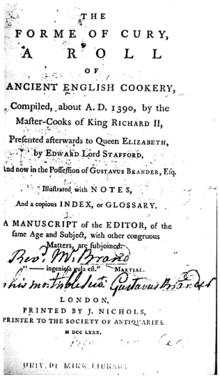Form of Cury
Forme of Cury is the name of a collection of recipes made by chefs at the court of King Richard II of England . The manuscript was written on parchment in Middle English around 1390 . It contains 205 recipes, the number of which varies with different copies of the work.
The name of this English recipe collection used to this day comes from the Briton Samuel Pegge (1704–1796), who had the work printed in 1780 and has since been used for various copies of the original manuscript. Together with other important medieval recipe collections, such as Le Viandier , Du fait de cuisine and Ménagier de Paris , it is probably the best-known recipe collection from the Middle Ages and is a key work for understanding the food culture of the Middle Ages . that she has adopted numerous recipes in modified form from Le Viandier .
From 2009 the facsimile of the old cookbook should be available digitally on the Internet. The John Rylands University Library is making the original publicly available worldwide.
Individual evidence
- ↑ See introduction to the text in the version of the Gutenberg project
- ↑ Royal toast. in: Der Spiegel. Hamburg 2008, 41,158. ISSN 0038-7452
literature
Numerous nutritional cultural histories mention Forme of Cury , for example
- Gert von Paczensky, Anna Dünnebier: Cultural history of eating and drinking . btb. Goldmann, Munich 1997. ISBN 3-442-72192-X
- Terence Scully: The Art of Cookery in the Middle Ages . Boydell, Woodbridge 1995. ISBN 0-85115-611-8
